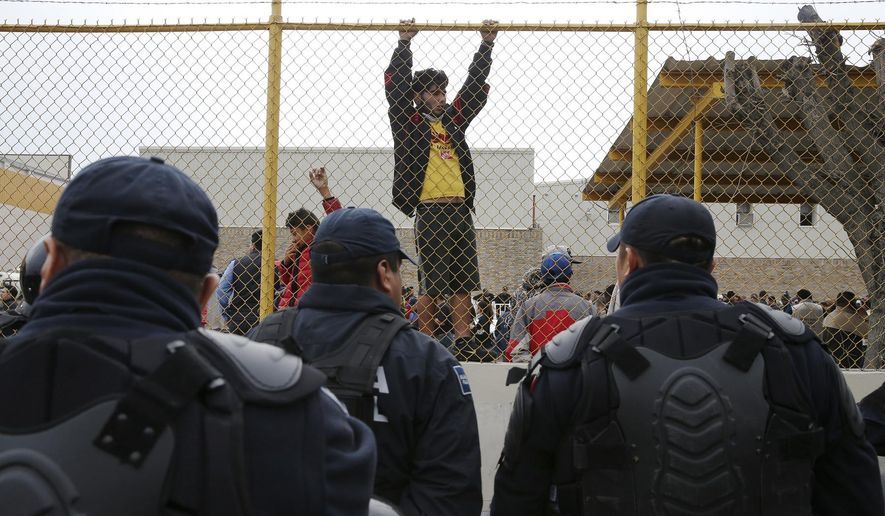The Supreme Court granted a reprieve Wednesday for the Trump administration’s Remain in Mexico policy, preserving — for now — the key tool that allowed the government to solve last year’s border crisis.
The justices said the policy, known officially as the Migrant Protection Protocols, can stay in effect while the Justice Department appeals a lower court injunction. That injunction had been slated to take effect Thursday, dissolving the MPP in Arizona and California.
It’s the latest in a string of rulings where the high court has allowed President Trump to proceed with get-tough immigration policies even after district courts had halted them.
The ruling also heads off Homeland Security’s nightmare situation that could have seen thousands of migrants forced to wait in Mexico under MPP make a rush for the border — and perhaps tens of thousands of new migrants from Latin America begin to make the journey.
“Today’s order from the Supreme Court is a major victory for the Trump administration,” declared White House press secretary Stephanie Grisham. She said the ruling “prevented dangerous chaos at the southern border, avoided a significant escalation in public health threats, and mitigated damage to foreign relations.”
One of those health threats Homeland Security officials had been eyeing was coronavirus.
So far this fiscal year, people from about 120 countries have been caught at the southwestern border, including hundreds from countries where the COVID-19 virus has taken hold, such as China, India and Brazil.
“Without proper precautions, which can only happen through orderly, lawful migration, the virus threatens to spread rapidly. Any halting of MPP would exacerbate this threat,” a department official told The Washington Times ahead of Wednesday’s ruling.
Wednesday’s decision was 8-1. Justice Sonia Sotomayor said she would have allowed the lower court injunction to go into effect, ending MPP in Arizona and California, the two border states under the jurisdiction of the 9th U.S. Circuit Court of Appeals, where the case originated.
Mr. Trump first raised the possibility of something like MPP in 2017, in his first set of immigration executive orders. But it took two years — and a change of administration in Mexico — for the administration to pull the trigger.
In the 14 months MPP has been operational, some 60,000 migrants from countries other than Mexico who had crossed that nation’s territory to reach the southwestern border have been returned to Mexico while their asylum claims are judged and usually rejected.
Immigrant rights activists say they’re being sent to certain violence, with cartels and gangs preying on them.
“Because of the administration’s misguided policy, thousands have endured kidnappings, assault, robbery, rape, and in some cases even murder, all in sight of our doorstep,” said the Rev. John L. McCullough, president of Church World Service, a major refugee organization.
The returned migrants are easy to spot: they are sent back without their shoelaces, activists say. American authorities confiscate laces for safety reasons in detention, and weren’t returning them before sending the migrants back.
MPP was ramped up last year amid the border surge. U.S. officials said migrants were flooding the border with bogus asylum claims, figuring correctly that they would be admitted and allowed to wait in the U.S. for their court dates, which could be years in the future. In the meantime many disappeared into the shadows. Some never even bothered to follow up on their asylum claims.
Under MPP, they were denied that foothold in the U.S.
Border Patrol officials say many MPP migrants gave up their claims and went home — proof, those officials said, that the original claims were meritless.
Border Patrol Chief Rodney Scott told reporters this week that if MPP disappeared, it would put pressure on other programs the U.S. has in place to deal with new unauthorized arrivals.
Among those are more speedy asylum-related decisions, and authority to send migrants to Central American countries.
But if those other programs can’t keep up, or if the message goes back to Latin America that people are crossing with impunity, “we can see another wave,” Chief Scott said.
A federal district court in California last year ruled MPP illegal, saying those who come seeking asylum are exempt from a part of the law that allows those who cross another country to reach the U.S. to be returned to that country.
The 9th U.S. Circuit Court of Appeals stayed that ruling, but late last month the court sided with the district judge and ruled the injunction could take effect.
The Justice Department said “chaos” erupted, with large groups of migrants storming border ports of entry demanding immediate entry.
The 9th Circuit then stayed its own decision to give the Justice Department a week to get the Supreme Court to weigh in. The deadline was Wednesday.
Judy Rabinovitz, a lawyer with the American Civil Liberties Union, said the justices bungled things.
“The court of appeals unequivocally declared this policy to be illegal. The Supreme Court should as well,” she said “Asylum seekers face grave danger and irreversible harm every day this depraved policy remains in effect.”
• Stephen Dinan can be reached at sdinan@washingtontimes.com.




Please read our comment policy before commenting.